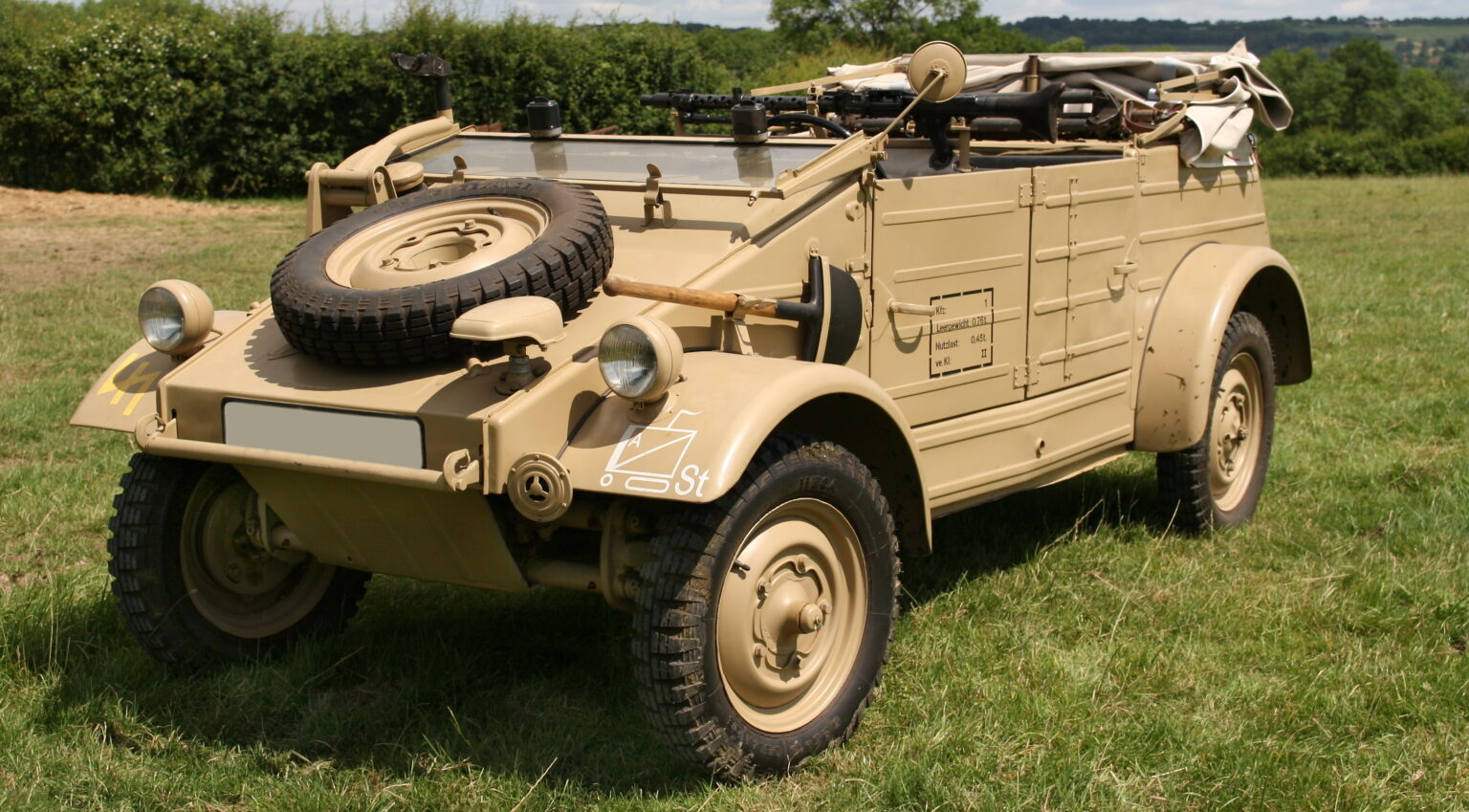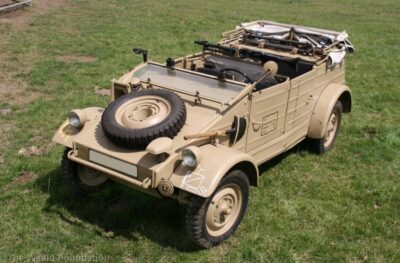There are many of examples of the Kübelwagen in existence today. Many of these are poorly restored and have used modern Volkswagen Beetle parts. In some cases the body may be little more than a rusting steel latticework filled with kilos of body filler. A good original vehicle is very rare.
There are a number of reasons to account for this. Firstly, there is the vehicle’s construction. It is thin sheet metal, spot welded and a natural water trap. Short of a total strip down, many of the parts within the body and chassis are not easily accessible. Secondly, many were kept running after the war by fitting spare parts from the phenomenally successful VW Beetle. These were cheap and easily available. What could not be replaced was the bodywork, hence the prodigious use of body filler.
The Foundation’s VW Typ 82 is an amalgamation of parts from three vehicles. The chassis and engine came from Normandy. The body, which also originally came from Normandy, was found in the UK mounted on a 1960s VW Beetle chassis. The decision to match the body to the chassis was based on archive research in the VW production archives. The chassis had been manufactured in mid-January 1944 and the body (number 37825) was from a VW82 Kübelwagen manufactured in late April 1944. The production dates were close enough to ensure they shared the same characteristics, making them a good match. The engine (number 2-052393) would have originally come from a VW 82 manufactured in March 1944. With the date of manufacture for all three major parts so close together, we were confident of being able to restore an authentic example of a VW Typ 82 Kübelwagen.
Any Kübelwagen restoration is greatly helped by the existence of considerable amounts of spare parts both re-conditioned and new.
The 1131cc engine was a typical example of a much used and modified “time served” unit. Eventually many existing parts had to be replaced with either reproduction parts or reconditioned original items. The same held for the gearbox, differential, front and rear axle assemblies, steering and braking systems.
A new wiring loom was built, and all the electrical parts refurbished and refitted. We also included wiring for a starter motor and button, stop lights, a pedal operated stop switch, main headlights, a foot operated head / dip switch and an offside rear light. These features were discontinued in any vehicle manufactured from early 1944 onwards in a bid to save on materials. The practical realities of using this vehicle on modern roads made it essential to incorporate all of these features. They would have been found on any Kübelwagen manufactured before late 1943.
The body required a mass of intricately made new inserts, ranging in size from only a few square centimetres up to new replacement panels, such as the outside sill panels and front bonnet. This damage was caused by the VW monocoque body trapping moisture, particularly where the steel sheet panels overlap. Typically these overlaps would be two or three layers of metal spot welded together.
The left and right internal sill panels are a continuous piece of pressed steel. They run from the rear where they support the rear body, via the sills to the front, where they support the front part of the body. The sills are pressed from a much thicker metal than the rest of the body panelling and support struts. This thicker steel member was carefully repaired, as it supports the entire body construction and is in effect a chassis member. The outer sill was removed to complete this work, and replaced with new panelling. Together they form a hollow box section acting as the hot air duct for the crew compartment heating system from the engine. It was therefore essential to get inside this otherwise sealed box section to cure any problems found inside.
At some point in the past the body had its original dashboard and windscreen support panelling cut away. It looked as if the dashboard area had been covered in a one piece of aluminium from left to right. All of the missing structure was restored, and new windscreen glass fitted.
Original side doors were sourced, along with later pattern engine and luggage compartment doors. All were restored to their original condition and fitted.
As mentioned above there is a warm air heating system that uses the hollow sills to conduct hot air forward at floor level. This feature was not on the earlier VW Kübelwagens, but was a standard fitting by early 1944. All the considerable tin work required for the control and delivery of the hot air was missing from the engine, but original examples were located and rebuilt. The exhaust pipes are boxed in with heat exchanger boxes. These collect the hot air via a three stage air flap. The air flap can be set to either direct all the hot air forward into the crew compartment, or expel all of it to the rear. The middle position directs the hot air forward and back in equal amounts
A new folding hood and removable side screens were fabricated from the 12 oz. natural flax, used for this vehicle type throughout WWII. The tubular seat frames were re-sprung and dressed with newly made material covers.
The vehicle was then finished in the standard Dunkelgelb (dark yellow) paint of the period. Throughout the restoration all completed items were either fitted onto the chassis floor pan or into the body shell. Eventually both parts of the vehicle were bolted together. At this point the 1944 vehicle restoration was complete.
It was now decided to go one stage further and fit out this Kübelwagen with the specific set of equipment required for the “Light Machine Gun” version. The WWII German document D633/9 dated April 22nd, 1942, details all the parts required for this version and the locations of these parts within the vehicle. The vehicle would carry an MG, a stowage rack for the MG, an MG anti-aircraft tripod, 14 ammunition tins, 8 belt drum magazines and two spare barrel containers.
D633/9 shows the main MG firing position to be a “swan neck” mounted over the front bodywork on the passenger side. The MG can be held in position when not firing by a clamp attached to the hand grip. The canvas covered MG stowage rack is mounted across the width of the vehicle behind the front seats and attached to the cross-body handrail. To allow room for this rack, the four rifle clips are repositioned a few centimetres further to the rear.
All 14 250-round ammunition boxes are contained within a steel box fixed into the rear luggage compartment. Surrounding this box are four of the belt drum magazines and a single and double spare barrel container. Mounted on the luggage compartment lid is the MG anti-aircraft tripod, with a secondary MG mount pivot located on the adjacent bodywork.
The remaining four belt drum magazines are fitted to the inside of the rear doors and a reinforcing steel strip runs down the exterior of these doors to help support the extra weight.
Contemporary WWII photographs identify this light MG VW Kübelwagen in use on several occasions in Normandy in 1944.
- This article has 1195 words
- Reading time: 5 minutes
- There are no photos
Become a Member - Access the Full Article
Members gain access to the full content of our articles, including photo galleries.


